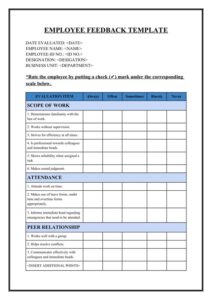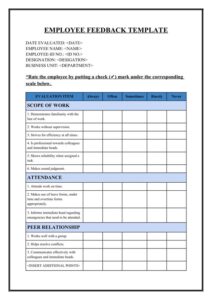In today’s dynamic work environment, understanding how employees perceive themselves and how they are perceived by others is crucial for growth. A 360-degree evaluation offers a comprehensive look at an individual’s performance, strengths, and areas for development by gathering feedback from various sources: peers, managers, direct reports, and even the individual themselves. It moves beyond the traditional top-down performance review, painting a more holistic picture that can truly foster professional and personal improvement.
Navigating the complexities of such an evaluation can seem daunting, but with the right tools, it becomes a powerful mechanism for feedback and development. That’s where having a well-structured employee 360 evaluation sample survey template comes in handy. It provides a foundational framework, ensuring you ask the right questions in a consistent manner, ultimately leading to more actionable insights and a fairer evaluation process.
Understanding the Core of 360-Degree Feedback
A 360-degree feedback system, also known simply as 360 feedback, is a developmental tool designed to help employees understand their strengths and weaknesses from multiple perspectives. It’s not primarily for performance ratings or salary decisions, but rather for personal and professional growth. Imagine receiving constructive insights not just from your boss, but from the colleagues you collaborate with daily and the team members you lead. This multi-rater feedback significantly enriches the development conversation, highlighting blind spots and reinforcing positive behaviors that might otherwise go unnoticed.
The beauty of 360 feedback lies in its ability to offer a well-rounded view. When feedback comes from all directions, including upward, downward, lateral, and self-assessment, it provides a much more robust data set than any single perspective ever could. This diverse input helps individuals see how their actions and behaviors impact different people within the organization, leading to a deeper understanding of their workplace presence and effectiveness. It fosters a culture of continuous learning and open communication.
For organizations, implementing a 360-degree feedback process can lead to improved teamwork, enhanced leadership capabilities, and a more engaged workforce. By regularly collecting and acting on this comprehensive feedback, companies can identify skill gaps, develop targeted training programs, and ensure that their talent development initiatives are aligned with real organizational needs. It’s a proactive approach to talent management that pays dividends in terms of employee satisfaction and overall business performance.
A well-designed employee 360 evaluation sample survey template serves as the backbone for this entire process. It ensures consistency, covers all critical areas, and makes the data collection phase efficient and unbiased. Without a structured approach, feedback can become anecdotal or too subjective, losing its developmental power.
Key Areas a Comprehensive Template Should Cover
When constructing or selecting your employee 360 evaluation sample survey template, consider including questions that touch upon these vital aspects of an employee’s professional life:
Crafting Your Employee 360 Evaluation Sample Survey Template
When you set out to create or customize an employee 360 evaluation sample survey template, think about the specific behaviors and competencies that are most valued within your organization. The goal isn’t just to gather data, but to gather actionable insights that can genuinely help an employee grow. Focus on questions that are clear, concise, and objective, aiming to elicit specific examples or observations rather than vague opinions. For instance, instead of asking “Are they a good leader?”, consider “Provide an example of how this individual has motivated their team in a challenging situation.”
The type of questions you include also matters significantly. A blend of rating scales (like Likert scales from “Strongly Disagree” to “Strongly Agree”) and open-ended questions often yields the most comprehensive feedback. Rating scales provide quantitative data that can be easily analyzed and tracked over time, while open-ended questions offer rich, qualitative insights that explain the “why” behind the ratings, providing context and specific examples that are invaluable for development planning.
Ensuring anonymity is paramount for the success of any 360-degree feedback process. When respondents feel secure that their feedback will not be directly attributed to them, they are more likely to provide honest and candid input. Clearly communicate the confidentiality measures in place before the survey begins. This builds trust and encourages participants to be open and forthcoming, which is essential for capturing a true picture of an employee’s performance and impact.
Finally, remember that the survey itself is just one part of the journey. The true value of an employee 360 evaluation sample survey template comes after the data has been collected and analyzed. It’s critical to provide employees with their results in a timely manner, coupled with constructive coaching or development discussions. This involves helping them interpret their feedback, identify key themes, and create a personal development plan based on the insights gained. Without this follow-through, the effort put into the evaluation might not translate into tangible growth.
Empowering employees with diverse perspectives on their performance can be a game-changer for individual development and organizational health. By thoughtfully designing and implementing a process around a robust template, you can unlock deeper self-awareness and foster a culture of continuous improvement across your teams.
Embracing this multifaceted approach to feedback not only benefits individual team members by highlighting their pathways for growth but also strengthens the entire organization by fostering a more transparent and development-focused culture. It’s about creating an environment where feedback is seen as a gift, leading to a more engaged, skilled, and effective workforce ready to tackle future challenges.


